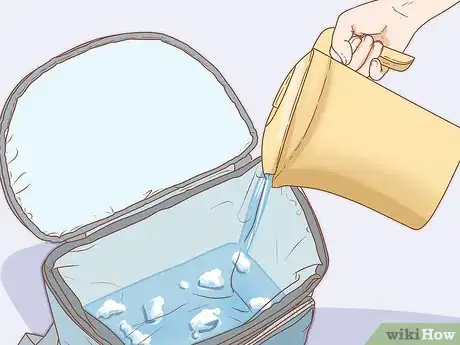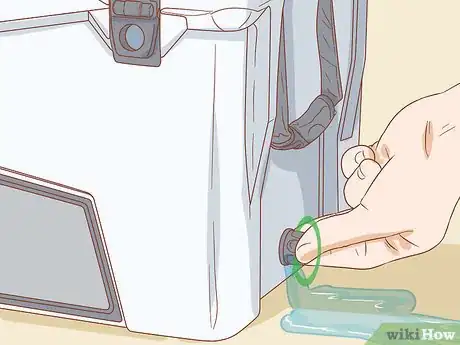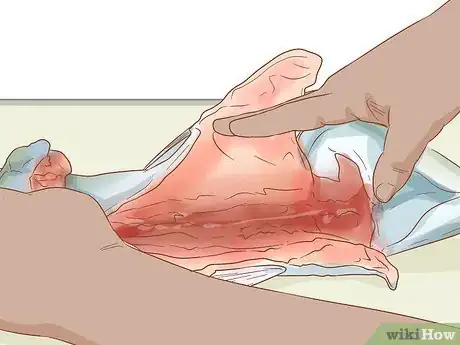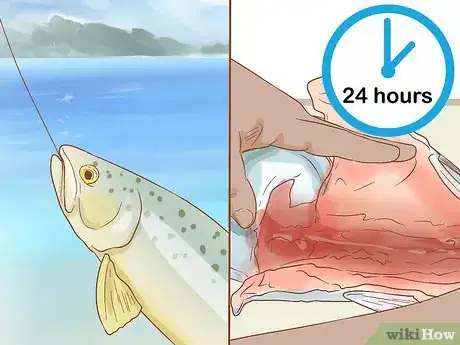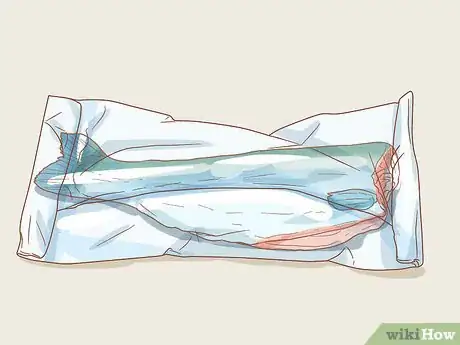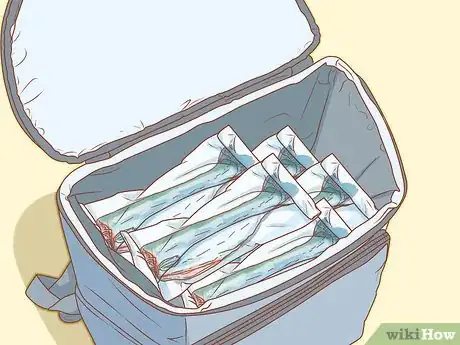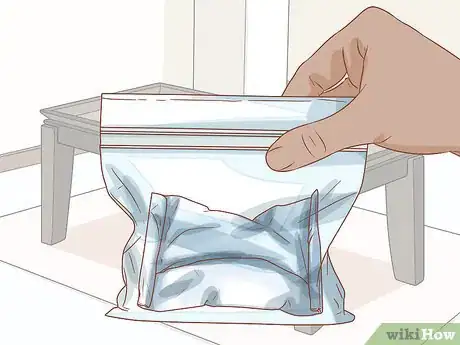This article was co-authored by wikiHow staff writer, Amber Crain. Amber Crain has been a member of wikiHow’s writing staff for the last six years. She graduated from the University of Houston where she majored in Classical Studies and minored in Painting. Before coming to wikiHow, she worked in a variety of industries including marketing, education, and music journalism. She's been a radio DJ for 10+ years and currently DJs a biweekly music program on the award-winning internet radio station DKFM. Her work at wikiHow supports her lifelong passion for learning and her belief that knowledge belongs to anyone who desires to seek it.
This article has been viewed 58,663 times.
Learn more...
Fresh fish needs to be stored in a particular way to prevent spoilage and keep it in prime condition before you cook and consume it. The key to preserving freshness is controlling the temperature – fresh fish needs to be chilled on ice from the moment it's caught until it's ready to be stored. If you are a fisherman, this means addressing the storage temperature as soon as you get the fish into your boat. If you're working with store-bought fresh fish, be prepared to properly store the meat on ice, carefully wrapped, until you're ready to cook or freeze it.
Steps
Storing Freshly Caught Fish
-
1Fill an insulated cooler with water and ice. If you are a fisherman, you need to start thinking about flavor preservation and storage temperature as soon as you get the fish into your boat. You have two options for maximum freshness. First, you can keep the fish alive in a live tank well onboard your boat and deal with the rest when you get back to shore.
-
2Add ice to and drain water from the cooler regularly. The fish needs to stay as cold as possible while in the cooler. Open the drain plug on the insulated cooler open so that melted ice water slowly and continuously drains out, making room for new ice. Do not allow dead fish to sit in melted ice water, because this will spoil the taste.[3]
- If possible, use shaved ice in the cooler. Position the fish down into the ice in the same position which they swim, bellies down.
- Surround their bodies completely with ice.
Advertisement -
3Remove the gills and stomachs as soon as you can. Cleaning the fish as soon as possible will preserve the most flavor. However, if you're out for a day of fishing, you probably won't be able to clean the fish right away. You can hold off on fully cleaning the fish for a few hours (as long as they're kept on ice) but you need to remove the gills and stomach cavities from the fish as soon as you possibly can.[4]
- Their gills and stomachs contain waste, and you need to remove that quickly to avoid spoiling the flavor of the meat.
- Removing these parts also allows you to pack the empty cavities with ice, so you can keep the fish even colder.
-
4Clean the fish within 24 hours of catching it. As long as they remain in a chilly bin and on frequently replenished ice, you can store whole fish for up to one day before cleaning them and still maintain flavor and freshness. Keep the stomach and gill areas packed with shaved ice. Be sure to keep them positioned upright, in the same position in which they would swim. This will allow the fish to easily drain any excess fluid out of the cavities. Cover the fish with more ice and close the cooler.[5]
- The fish won't be slimy when you take them out to clean them, because they've been kept on well-drained and frequently replenished ice. This makes them easier to handle.
- There won't be a strong or unpleasant fishy odor when you take them out to clean them. Cutting and slicing the meat will be easier, too.
Refrigerating Fresh Fish
-
1Rinse the freshly cleaned fish under cold water. Before putting fish in the refrigerator, give the cleaned pieces a good rinsing to make sure there are no remaining scales or other detritus. Use the coldest water your faucet will produce. Never rinse a fresh fish in lukewarm or hot water. After rinsing, gently pat the pieces dry with a paper towel or a clean cloth.[6]
-
2Wrap the meat tightly in wax paper, plastic wrap or aluminum foil. Once you have the fish all wrapped up, seal the ends tightly so that the meat isn't exposed to air. Oxygen can contribute to spoilage, especially in fatty fish like salmon or mackerel.[7] You also don't want any ice to get in the packaging.
- Never allow fresh fish meat to directly touch or sit in the ice. Always wrap the fish in something first, to protect it.
- If you've brought home store-bought fresh fish, keep the meat in its original wrapper.[8]
-
3Place the wrapped fish on ice.[9] The key to storing fresh fish is keeping the meat on ice and as cold as possible until you are ready to cook it. After wrapping the meat, place the bundles back into an ice-filled insulated cooler. Once you've nestled the wrapped pieces into the ice, fill a few plastic baggies loosely with more shaved ice and seal them tightly to ensure there will be no leakage.
- You want there to be one to two inches of ice in the baggies.
- Place these ice baggies on top of the fish.> Close the lid of the cooler tightly.
-
4Put the cooler into your refrigerator and store for up to two days.[10] Situate an empty bin beneath the cooler and open the drain plug to allow melted ice to run out of the cooler. The bin will catch the run-off. You will need to empty this bin periodically. Make sure the melted water is flowing freely out of the drain plug. Even though the fish is wrapped, you still do not want it sitting in water.[11] The ice baggies need to be replenished daily.
- Large pieces of fish will store better than small pieces in the refrigerator.
- Lean fish (panfish, bass, walleye, flounder, sole, red fish, catfish, cod) will hold up better in the refrigerator than fatty fish (trout, salmon, herring, tuna, mackerel, carp, Chilean sea bass).
Freezing Fish for Future Use
-
1Place the cleaned fish into freezer-safe plastic baggies. Before you seal them closed, make sure you press out all of the air from the baggies, or at least as much as you can. Oxygen can lead to loss of flavor and faster spoilage. Once the bags are air-free, seal them tightly so that no air is able to get into them.
- To be safe, it's best to wrap the plastic baggies first in aluminum foil and then in moisture-proof freezer paper before placing them into your freezer.[12]
-
2Freeze the fresh fish in a solid block of ice. This is an alternate way to safely freeze fresh fish without having to seal the pieces in plastic baggies. Place the fish meat directly into a clean, freezer-safe refrigerator container. Fill the container up with water until the water is just covering the fish. Place the container into the freezer.
- The frozen block of ice surrounding the fish will prevent oxygen from reaching the flesh.[13]
-
3Consume the frozen fish within twelve months. As long as you've prepared the fish well in air-tight baggies before storing them in the freezer, most frozen fish will be good for up to twelve months. For the absolute best taste and freshness, consume the fish within the first three months. Keep in mind that lean fish will have a longer shelf life than fatty fish.[14]
- When you're ready to cook the fish, thaw the meat by placing it into your refrigerator overnight.
- Never thaw fish in a microwave or by setting it out at room temperature.
Community Q&A
-
QuestionWhy do we need to follow the guidelines in storing fish and seafoods?
 Community AnswerYou need to follow these guidelines so your food doesn't go bad and cause illness to yourself or others.
Community AnswerYou need to follow these guidelines so your food doesn't go bad and cause illness to yourself or others.
References
- ↑ http://www.bishfish.co.nz/articles/general/icecold.htm
- ↑ https://www.takemefishing.org/how-to-fish/how-to-catch-fish/how-to-store-a-fish/
- ↑ https://www.takemefishing.org/how-to-fish/how-to-catch-fish/how-to-store-a-fish/
- ↑ https://www.takemefishing.org/how-to-fish/how-to-catch-fish/how-to-store-a-fish/
- ↑ https://www.takemefishing.org/how-to-fish/how-to-catch-fish/how-to-store-a-fish/
- ↑ https://www.takemefishing.org/how-to-fish/how-to-catch-fish/how-to-store-a-fish/
- ↑ https://www.fda.gov/food/buy-store-serve-safe-food/selecting-and-serving-fresh-and-frozen-seafood-safely
- ↑ http://www.wholefoodsmarket.com/about-our-products/food-safety/handling-seafood-safely
- ↑ https://www.takemefishing.org/how-to-fish/how-to-catch-fish/how-to-store-a-fish/
- ↑ https://www.fda.gov/food/buy-store-serve-safe-food/selecting-and-serving-fresh-and-frozen-seafood-safely
- ↑ https://www.takemefishing.org/how-to-fish/how-to-catch-fish/how-to-store-a-fish/
- ↑ https://www.takemefishing.org/how-to-fish/how-to-catch-fish/how-to-store-a-fish/
- ↑ https://www.takemefishing.org/how-to-fish/how-to-catch-fish/how-to-store-a-fish/
- ↑ https://www.takemefishing.org/how-to-fish/how-to-catch-fish/how-to-store-a-fish/
About This Article
To store fish, start by wrapping it tightly with plastic wrap or aluminum foil, which will keep out oxygen so it doesn't spoil. If you plan on eating the fish within a couple of days, you can store it on ice in a cooler that's kept in a fridge. If you store the fish this way, empty out the cooler every day and add more ice to keep the fish fresh. You can also store the fish in a freezer for up to 12 months. Just put it in a freezer bag, press out the excess air, and place it in the freezer. If you want to learn how to store fish that you just caught, keep reading the article!
